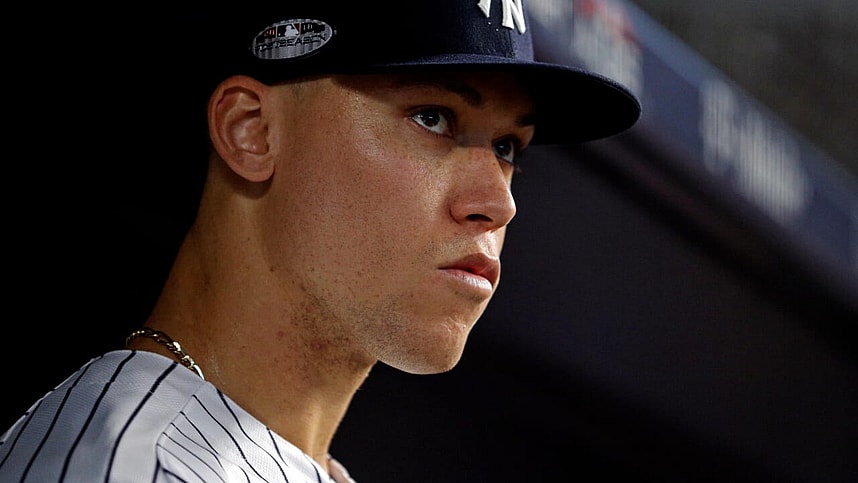
I know what you’re thinking: how in the world was José Altuve crowned the title of AL MVP in 2017? Better yet, why am I writing an article about this 2 years after the decision was determined?
Am I an angry Scrooge that doesn’t understand how to release pent-up anger brewing for over 2 years? Actually, it’s much more simple than that.
As a lover of baseball and knowledge, I want to learn in full detail why Altuve was chosen over Aaron Judge. Not because of the recent cheating scandal or because I’m furious, but because I’m genuinely curious.
Aaron Judge comments on taking down his Jose Altuve MVP post: "They cheated. You know, that didn’t sit well with me and I just didn’t feel like, the post, the post that I did, really meant the same anymore."#TMKSonYES pic.twitter.com/MTzzSNSrXf
— YES Network (@YESNetwork) February 18, 2020
First off, let’s begin with the most basic and overused statistic on the planet; batting average. In the 2017 season, Altuve posted a .346 AVG, while Judge posted a .284 AVG. Sure, Altuve posted a much higher AVG compared to Judge, but in the grand scheme of baseball, does it mean you’re an overall better player? Should the title of MVP be decided by AVG in a day in the age of advanced analytics?
Shorts answer…absolutely not. Why? Well, batting average doesn’t remotely explain the whole tale on how a player performed offensively. It ignores a whole chunk of production, such as walks and sacrifice flies and values all hits equally.
A much more dependable alternative is OBP. While it shouldn’t be utilized as an end-all result either, it’s much more reliable as it accounts for hit-by-pitches and walks. However, it doesn’t account for factors such as errors committed by defenders, dropped third strikes and when hitters reach base on a fielder’s choice.
To put this all in perspective, anything that doesn’t mention batting average is ideal for evaluating offensive production. As mentioned earlier, Altuve beat out Judge in AVG, but what about OBP, SLG, OPS, wOBA and wRC+? What about defensive metrics, such as DRS and UZR?

Yeah…other than AVG, hits, stolen bases and bWAR is the only noticeable stats that Altuve had a better quantity of. Altuve may have accumulated a soaring AVG, but was left in the dust in just about every other category.
For OBP, Judge was .012 points higher, which isn’t conclusive enough to make much of a difference. However, his SLG was .080 points higher, his OPS was .092 points higher and his wRC+ was 13 points higher. If you want to factor in wOBA, Altuve accumulated a .405 wOBA, while Judge accumulated a .430 wOBA, .025 points higher than Altuve.
We have already discussed why OBP is a better option than AVG, but what about SLG, OPS, wOBA, and wRC+? Why are these stats prime candidates of choice?
Let’s begin with SLG, which depicts the sum of bases a player records per at-bat. Unlike AVG, SLG values hit much differently. Doubles are worth more than singles, triples are worth more than doubles and home runs rain superior over all possible outcomes.
OPS is relatively easy to explain, as it’s a player’s OBP and SLG added together. Short, simple and straight to the point.
wOBA is a bit more complicated to explain. wOBA, or weighted on-base average, is utilized to measure a hitter’s offensive value more precisely and is simliar to SLG, but doesn’t calculate doubles as twice the value of singles or home runs as quadruple the value of singles.
wRC+, or weighted runs created plus, is the collective calculation of all offensive production introduced in a single statistic. Instead of sorting through numbers like home runs and walks recorded, wRC+ takes all production, including ballpark and league-adjusted factors into account. This statistic is the most accurate and finest method of comparing players across all eras.
With all of this being said, it’s clear on why Judge had the superior season. He recorded 28 more home runs and broke the single-season rookie record, which has now been surpassed by Pete Alonso. Judge also boasted 12 more extra-base hits, walked 69 more times and cashed in 33 more RBI (even though RBI are based on luck and there is slight confirmation that clutch hitting is a separate skill from regular hitting)
Moving on to defense, Judge saved 6 more runs than Altuve. This is important because DRS, or defensive runs saved, is much more predominant among infielders opposed to outfielders.
Secondly, Judge racked up a higher UZRÂ or ultimate zone rating by 8.3 points. This defensive metrics includes many different components and is popular for quantifying how many runs a player allowed or saved. Overall, Judge surpassed Altuve in outfield arm runs, range runs and error runs.
- Outfield Arm Runs (ARM) – The number of runs above average an outfielder saves with their arm by preventing runners from advancing.
- Range Runs  (RngR) – Is the player an Ozzie Smith or an Adam Dunn? Do they get to more balls than average or not?
- Error Runs (ErrR) – Does the player commit more or fewer errors compared with a league-average player at their position?
Last, but certainly not least, Altuve accumulated a higher bWAR by 0.4 points, but a lower fWAR by 0.7 points. bWAR is the Baseball-References version of WAR, while fWAR is Fangraphs version of WAR. Both are identical in how they value hitting, fielding, base running, and other positional factors.
In this case, it’s all about personal preference. In my opinion, fWAR is a better tool to utilize because I relate to wOBA and wRC+ compared to OPS+. However, in no way, shape or form should bWAR ever be considered futile.
So…Judge over Altuve? Maybe? I sure think he deserved it rightfully so, but I’m also not a baseball voter who decides the outcome of regular-season awards.
More about: New York Yankees MLB
/cdn.vox-cdn.com/uploads/chorus_asset/file/8111421/wOBA_scale.PNG)
/cdn.vox-cdn.com/uploads/chorus_asset/file/8111703/wRC__scale.PNG)